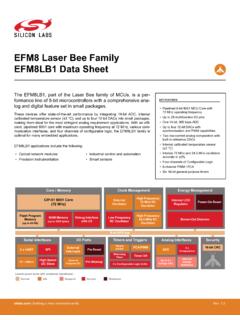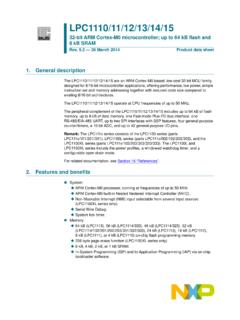Transcription of SAM9X60 SIP Data Sheet
1 SAM9X60 SIP. SAM9X60 System-In-Package (SIP) MPU with up to 1 Gbit DDR2 SDRAM and up to 64 Mbits SDR-SDRAM. Scope This document is an overview of the main features of the SAM9X60 SIP microprocessor. The sole reference documents for product information on the SAM9X60 and the DDR2/SDR-SDRAM memories are listed in Reference Documents. Introduction . The SAM9X60 SIP integrates the ARM926EJ-S Arm Thumb processor-based SAM9X60 MPU with up to 1-Gbit DDR2-SDRAM or 64-Mbit SDR-SDRAM in a single package. By combining the SAM9X60 with DDR2/SDR-SDRAM in a single package, PCB routing complexity, area and number of layers are reduced in the majority of cases.
2 This makes board design easier and more robust by facilitating design for EMI, ESD and signal integrity. DDR2-SDRAM memory sizes and package options available: 512-Mbit and 1-Gbit DDR2-SDRAM, TFBGA233. SDR-SDRAM memory sizes and package options available: 64-Mbit SDRAM, TFBGA196. While the smallest option targets applications with a small OS or bare metal, the larger options are suitable for . applications using Linux . Reference Documents Type Document Title Available Ref. No. Data Sheet SAM9X60 DS60001579. SAM9X60 Device Silicon Errata and Errata DS80000846. Data Sheet Clarification 8 Mwords 4 Banks 16 bits Data Sheet W9751G6KB.
3 DDR2 SDRAM (512 Mbits). 8 Mwords 8 Banks 16 bits Data Sheet W971GG6SB. DDR2 SDRAM (1 Gbit). 1 Mword x 4 Banks x 16 bits SDR. Data Sheet W9864G6KH. SDRAM (64 Mbits). 2021 Microchip Technology Inc. Datasheet DS60001580C-page 1. and its subsidiaries SAM9X60 SIP. Features CPU. ARM926EJ-S Arm Thumb processor running up to 600 MHz 32-Kbyte data cache, 32-Kbyte instruction cache, Memory Management Unit (MMU). Memories One 160-Kbyte internal ROM. 64-Kbyte internal ROM embedding a secure bootloader program supporting boot on NandFlash, SDCard, SPI or QSPI flash . bootloader features selectable by OTP bits.
4 96-Kbyte ROM for NAND flash BCH ECC table DDR2-SDRAM memory up to 1 Gbit or 64-Mbit SDR-SDRAM memory, 16-bit data bus One 64-Kbyte internal SRAM (SRAM0), single-cycle access at system speed High Bandwidth Multi-port DDR2/LPDDR Controller (MPDDRC). 8-bit External Bus Interface (EBI) supporting 8-bit NAND flash connected on D16-D23. NAND flash Controller, with up to 24-bit Programmable Multi-bit Error Correcting Code (PMECC). One 11-Kbyte OTP memory for secure key storage with emulation mode (OTP bits are emulated by a 4-Kbyte SRAM (SRAM1)). System Running up to 200 MHz Power-on Reset cells, Reset Controller, Shutdown Controller, Periodic Interval Timer, Watchdog Timer running on internal low-power 32-kHz RC and Real Time Clock running on external crystal Two internal trimmed RC oscillators: 32 kHz (low-power) and 12 MHz Two selectable crystal oscillators: kHz (low-power) and 8 to 50 MHz One PLL for the system and one PLL optimized for USB high-speed operation (480 MHz).
5 One dual-port 16-channel DMA Controller (XDMAC). Advanced Interrupt Controller (AIC) and Debug Unit (DBGU). JTAG port with disable bit in OTP memory Two programmable external clock signals Low Power Modes Backup mode with RTC, eight 32-bit general purpose backup registers, and Shutdown Controller to control the external power supply Clock Generator and Power Management Controller Software-programmable Ultra-Low Power modes: Very Slow Clock Operating Mode (ULP0), and No-Clock Operating Mode (ULP1) with fast wake-up capabilities Software programmable power optimization capabilities Peripherals LCD Controller with overlay, alpha-blending, rotation, scaling and color conversion.
6 Up to 1024 x 768. resolution 2D Graphics Controller supporting Fill BLT, Copy BLT, Transparent BLT, Blend/Alpha BLT, ROP4 BLT. (Raster Operations) and Command Ring Buffer ITU-R BT. 601/656, up to 12-bit Image Sensor Interface (ISI). One USB Device High Speed, three USB Host High Speed with dedicated On-Chip Transceivers Two 10/100 Mbps Ethernet Mac Controller Two 4-bit Secure Digital MultiMedia Card Controller (SDMMC). Two CAN Controllers One Quad I/O SPI Controller Two three-channel 32-bit Timer/Counters One high resolution (64-bit) Periodic Interval Timer One Synchronous Serial Controller One Inter-IC Sound (I S) Multi-Channel Controller (I2 SMCC) with TDM support One Audio Class D Controller with Single-Ended (SE) or Bridge Tied Load (BTL) connection to power stage One four-channel 16-bit PWM Controller 2021 Microchip Technology Inc.
7 Datasheet DS60001580C-page 2. and its subsidiaries SAM9X60 SIP. Thirteen FLEXCOMs (USART, SPI and TWI). One 12-channel 12-bit Analog-to-Digital Converter with 4/5 wires resistive touchscreen support Hardware Cryptography SHA (SHA1, SHA224, SHA256, SHA384, SHA512): compliant with FIPS PUB 180-2. AES: 256-, 192-, 128-bit key algorithm, compliant with FIPS PUB 197. TDES: two-key or three-key algorithms, compliant with FIPS PUB 46-3. True Random Number Generator (TRNG) compliant with NIST Special Publication 800-22 Test Suite and FIPS PUBs 140-2 and 140-3. I/O Ports Four 32-bit Parallel Input/Output Controllers Up to 112 programmable I/O Lines multiplexed with up to three peripheral I/Os Input change interrupt capability on each I/O line, optional Schmitt trigger input Individually programmable open-drain, pull-up and pull-down resistor, synchronous output General-purpose analog and digital inputs tolerant to positive and negative current injection Package DDR2-SDRAM variant: 233-ball BGA, 14x14 mm , mm pitch, optimized for standard class PCB layout (down to 2 layers).
8 SDR-SDRAM variant: 196-ball BGA, 11x11 mm , mm pitch, optimized for standard class PCB layout (down to 4 layers). Design for Low Electromagnetic Interference (EMI). Slew rate controlled I/Os DDR/SDR Phy with impedance-calibrated drivers Spread spectrum PLLs Careful BGA power/ground ball assignment to provide optimum decoupling capacitors placement Operating Conditions Ambient temperature range (TA): -40 C to +85 C. Junction temperature range (TJ) : -40 C to +125 C. 2021 Microchip Technology Inc. Datasheet DS60001580C-page 3. and its subsidiaries SAM9X60 SIP. Table of Contents 1. Reference 2.
9 1. DDR2-SDRAM 6. 2. SDR-SDRAM 7. 3. Configuration 8. 4. Block 5. Chip 10. 6. Package and 7. 24. 8. Electrical 25. Power 25. 9. Mechanical 26. 233-Ball 26. 196-Ball 30. 10. Ordering 34. 11. Revision 35. DS60001580C - 09 DS60001580B - 02 DS60001580A - 10 The Microchip product Change Notification Customer 36. product Identification Microchip Devices Code Protection 37. Legal 38. 38. Quality Management 39. 2021 Microchip Technology Inc. Datasheet DS60001580C-page 4. and its subsidiaries SAM9X60 SIP. Worldwide Sales and 2021 Microchip Technology Inc. Datasheet DS60001580C-page 5. and its subsidiaries SAM9X60 SIP.
10 DDR2-SDRAM Features 1. DDR2-SDRAM Features Part Numbers: 1-Gbit DDR2-SDRAM device (SAM9X60D1G-I): Winbond W971G16SG2-5I. 512-Mbit DDR2-SDRAM device (SAM9X60D5M-I): Winbond W975116KG2-5I. Power Supply: DDRM_VDD = Double Data Rate Architecture: Two Data Transfers per Clock Cycle CAS Latency: 3. Burst Length: 8. Bi-Directional, Differential Data Strobes (DQS and DQSN) are Transmitted/Received with Data Edge-Aligned with Read Data and Center-Aligned with Write Data DLL Aligns DQ and DQS Transitions with Clock Differential Clock Inputs (CLK and CLKN). Data Masks (DM) for Write Data Commands Entered on Each Positive CLK Edge, Data and Data Mask are Referenced to Both Edges of DQS.

















